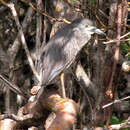en
names in breadcrumbs


A small (22-28 inches), thick-set heron, the Yellow-crowned Night-Heron is most easily identified by its gray body, black face with white cheek patch, and conspicuous yellow crown. Where their ranges overlap, this species may be distinguished from its relative, the Black-crowned Night Heron (Nycticorax nycticorax), by the latter species’ pale face, pale breast, and, logically, by its black crown. Male and female Yellow-crowned Night-Herons are similar in all seasons. The Yellow-crowned Night Heron breeds in the eastern and southeastern United States south to Brazil. In winter, populations breeding in northern and interior portions of this species’ range migrate south to the coasts and the tropics. Coastal-breeding populations, as well as those breeding in the tropics, are non-migratory. Yellow-crowned Night-Herons inhabit a variety of wetland habitats, whether flowing or standing, large or small, and freshwater or saltwater. In tropical areas, this species may be found in mangrove wetlands and lagoons. Unlike the Black-crowned Night-Heron, the Yellow-crowned Night Heron specializes in eating crustaceans, especially crabs. Yellow-crowned Night-Herons may be best observed wading in shallow water, where they may be seen plunging their bills into the water to catch crabs. It is also possible to see Yellow-crowned Night Herons at their small nesting colonies, especially when they return to roost, or while flying with their feet extended and their necks pulled in. As its name suggests, this species hunts mainly from sunset to sunrise, although individuals may be seen during the morning and afternoon as well.